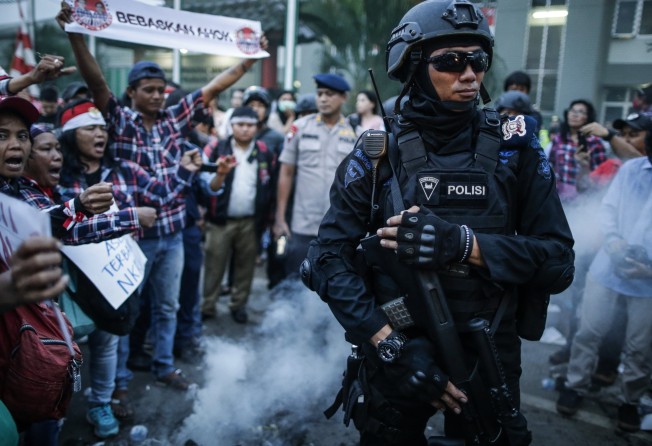‘Fake news’ can be very dangerous, and events this year in Asia proved it
In Indonesia, Myanmar and the Philippines, misinformation and disinformation may have made already bad situations worse

By Nyshka Chandran
Fake news influenced three violent political events in Asia this past year, emerging as a strategic weapon for civilian and state actors to deepen societal divisions.
“The more pervasive the politics of nationalism, the more ubiquitous fake news will be,” he said.
From elections in Indonesia to Myanmar’s Rohingya crisis to the Philippine drug war, the spread misinformation and disinformation have been used to bolster hate speech, stereotypes and propaganda.
Within the region, “fake news is closely linked to domestic politics and in particular, the rise of nationalism,” explained Mustafa Izzuddin, a fellow at Singaporean think tank ISEAS-Yusof Ishak Institute. Nationalist politics coupled with ethno-religious undertones boosted the circulation of fake news in Indonesia, Myanmar and the Philippines, he continued.
“The more pervasive the politics of nationalism, the more ubiquitous fake news will be,” he said.
Anti-Chinese, anti-Christian rhetoric
In Jakarta, charges of blasphemy against Governor Basuki Tjahaja Purnama fueled deliberately inaccurate stories about the politician that were disseminated in an effort to prevent him from winning re-election in April’s gubernatorial vote.
Focusing on his Chinese ethnicity and Christian beliefs, those articles tapped into Indonesia’s deeply-rooted religious divisions by alleging that Basuki, commonly known as Ahok, was part of a Chinese conspiracy to control the country, triggering violent clashes.
Those reports said Ahok, who was eventually sentenced to two years in prison, was a Chinese agent and that his free Human Papillomavirus vaccination programme could result in female infertility. Police recently confirmed that many of the articles were part of a campaign organised by Saracen, an online syndicate in the business of creating and spreading hoaxes for profit. It’s not clear, however, who Saracen’s clients were.
Minimising real atrocities
In Myanmar, both civilians and the state are responsible for creating misleading information regarding Rohingya Muslims, an ethnic group widely regarded as illegal immigrants by the country’s Buddhist-majority population.
Brutality by security forces and Buddhists against Rohingya has been called “ethnic cleansing” by the United Nations, though the government denies it.
Local media also paint a different picture. Newspapers have claimed that the Rohingya are burning down their own homes and killing Buddhists and Hindus — a view also espoused by the government. That’s led many Burmese to doubt reported incidents of human rights abuses against the Rohingya.
Fallacious images shared on social media are also obscuring the real narrative. Turkish Deputy Prime Minister Mehmet Simsek recently tweeted an image of corpses with a message warning of the Rohingya’s plight, but the images did not in fact depict Myanmar. In response, de facto leader Aung San Suu Kyi said fake news was “promoting the interests of terrorists,” a reference to Rohingya insurgents.
Meanwhile, misleading articles in favour of Philippine President Rodrigo Duterte have bolstered the leader’s strongman image. Those include hoax endorsements for the president, such as one from NASA that incredibly called Duterte “the best president in the solar system.”
An Oxford University study this year claimed that the Duterte campaign spent US$200,000 on internet “trolls” to attack critics and spread pro-government propaganda that has the look of legitimate news articles.
That’s complicated public discourse around the president’s controversial policies. For example, alleged extrajudicial killings in the ongoing drug war are dismissed as fake news by Duterte supporters while death toll figures reported by foreign media are routinely dismissed by government officials, causing many citizens to doubt the severity of the situation.
Destructive power of social media
While fake news is a global phenomenon, it is particularly relevant for Southeast Asia — a region still relatively new to the idea of free cyberspace.
“For the first time in most people’s lives, they now have access to non-censored information by the state,” explained Aim Sinpeng, a politics professor at the University of Sydney. The region boasts a long history of state-controlled information through traditional media outlets, but the online world remains far less regulated by comparison.
“Millions of Southeast Asians who have access to the internet for the first time now also have access to a sludge of information that has largely been unmitigated by state control,” Sinpeng said, adding that Facebook is now the main source of news for many Southeast Asians, the majority of whom trust information shared by friends in their networks.
That’s created an ideal breeding ground for purveyors of false reports.
Facebook can create an echo chamber effect in which people only read information from like-minded peers while the platform’s algorithms also produce “filter bubbles” that feed users information based on previous behaviour, Sinpeng explained. “Both of these help to further exacerbate the spread of both misinformation and disinformation.”
Experts widely agree that efforts must be taken to improve digital literacy in the region, encouraging individuals to fact-check and corroborate news.